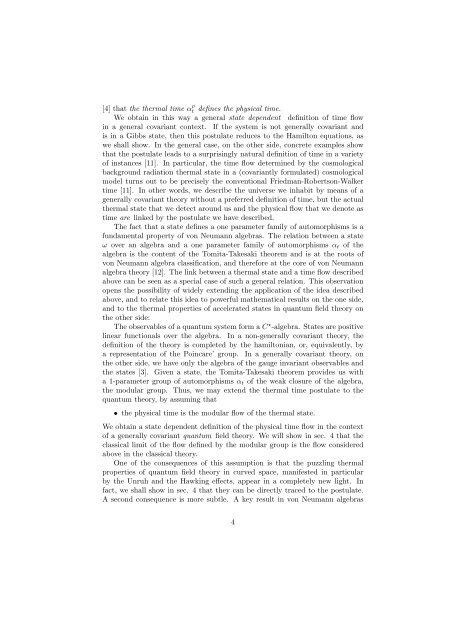Von Neumann algebra automorphisms and time ... - Alain Connes
Von Neumann algebra automorphisms and time ... - Alain Connes
Von Neumann algebra automorphisms and time ... - Alain Connes
You also want an ePaper? Increase the reach of your titles
YUMPU automatically turns print PDFs into web optimized ePapers that Google loves.
[4] that the thermal <strong>time</strong> α ρ<br />
t defines the physical <strong>time</strong>.<br />
We obtain in this way a general state dependent definition of <strong>time</strong> flow<br />
in a general covariant context. If the system is not generally covariant <strong>and</strong><br />
is in a Gibbs state, then this postulate reduces to the Hamilton equations, as<br />
we shall show. In the general case, on the other side, concrete examples show<br />
that the postulate leads to a surprisingly natural definition of <strong>time</strong> in a variety<br />
of instances [11]. In particular, the <strong>time</strong> flow determined by the cosmological<br />
background radiation thermal state in a (covariantly formulated) cosmological<br />
model turns out to be precisely the conventional Friedman-Robertson-Walker<br />
<strong>time</strong> [11]. In other words, we describe the universe we inhabit by means of a<br />
generally covariant theory without a preferred definition of <strong>time</strong>, but the actual<br />
thermal state that we detect around us <strong>and</strong> the physical flow that we denote as<br />
<strong>time</strong> are linked by the postulate we have described.<br />
The fact that a state defines a one parameter family of <strong>automorphisms</strong> is a<br />
fundamental property of von <strong>Neumann</strong> <strong>algebra</strong>s. The relation between a state<br />
ω over an <strong>algebra</strong> <strong>and</strong> a one parameter family of <strong>automorphisms</strong> αt of the<br />
<strong>algebra</strong> is the content of the Tomita-Takesaki theorem <strong>and</strong> is at the roots of<br />
von <strong>Neumann</strong> <strong>algebra</strong> classification, <strong>and</strong> therefore at the core of von <strong>Neumann</strong><br />
<strong>algebra</strong> theory [12]. The link between a thermal state <strong>and</strong> a <strong>time</strong> flow described<br />
above can be seen as a special case of such a general relation. This observation<br />
opens the possibility of widely extending the application of the idea described<br />
above, <strong>and</strong> to relate this idea to powerful mathematical results on the one side,<br />
<strong>and</strong> to the thermal properties of accelerated states in quantum field theory on<br />
the other side:<br />
The observables of a quantum system form a C ⋆ -<strong>algebra</strong>. States are positive<br />
linear functionals over the <strong>algebra</strong>. In a non-generally covariant theory, the<br />
definition of the theory is completed by the hamiltonian, or, equivalently, by<br />
a representation of the Poincare’ group. In a generally covariant theory, on<br />
the other side, we have only the <strong>algebra</strong> of the gauge invariant observables <strong>and</strong><br />
the states [3]. Given a state, the Tomita-Takesaki theorem provides us with<br />
a 1-parameter group of <strong>automorphisms</strong> αt of the weak closure of the <strong>algebra</strong>,<br />
the modular group. Thus, we may extend the thermal <strong>time</strong> postulate to the<br />
quantum theory, by assuming that<br />
• the physical <strong>time</strong> is the modular flow of the thermal state.<br />
We obtain a state dependent definition of the physical <strong>time</strong> flow in the context<br />
of a generally covariant quantum field theory. We will show in sec. 4 that the<br />
classical limit of the flow defined by the modular group is the flow considered<br />
above in the classical theory.<br />
One of the consequences of this assumption is that the puzzling thermal<br />
properties of quantum field theory in curved space, manifested in particular<br />
by the Unruh <strong>and</strong> the Hawking effects, appear in a completely new light. In<br />
fact, we shall show in sec. 4 that they can be directly traced to the postulate.<br />
A second consequence is more subtle. A key result in von <strong>Neumann</strong> <strong>algebra</strong>s<br />
4


